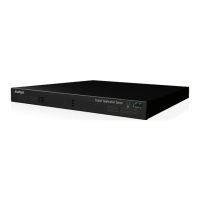SRTP Secure Real-time Transport Protocol (SRTP) adds security to the standard
RTP protocol, which is used to send media (video and audio) between
devices in SIP calls. It offers security with encryption, authentication and
message integrity. The encryption uses a symmetric key generated at the
start of the call, and being symmetric, the same key locks and unlocks the
data. So to secure transmission of the symmetric key, it is sent safely
during call setup using TLS.
SSO
See Single Sign On on page 55.
Standard Definition See SD on page 55.
Streaming Streaming is a method to send live or recorded videoconferences in one
direction to viewers. Recipients can only view the content; they cannot
participate with a microphone or camera to communicate back to the
meeting. There are two types of streaming supported in Scopia
®
Solution:
unicast which sends a separate stream to each viewer, and multicast which
sends one stream to a range of viewers.
STUN
A STUN server enables you to directly dial an endpoint behind a NAT or
firewall by giving that computer’s public internet address.
SVC SVC extends the H.264 codec standard to dramatically increase error
resiliency and video quality without the need for higher bandwidth. It is
especially effective over networks with high packet loss (like wireless
networks) which deliver low quality video. It splits the video stream into
layers, comprising a small base layer and then additional layers on top
which enhance resolution, frame rate and quality. Each additional layer is
only transmitted when bandwidth permits. This allows for a steady video
transmission when available bandwidth varies, providing better quality
when the bandwidth is high, and adequate quality when available
bandwidth is poor.
SVGA
SVGA defines a video resolution of 800 x 600 pixels.
Switched video Switching is the process of redirecting video as-is without transcoding, so
you see only one endpoint's image at a time, usually the active speaker,
without any video layouts or continuous presence (CP). Using video
switching increases the port capacity of the Scopia
®
Elite MCU only by four
times.
Important:
Use switched video only when all endpoints participating in the
videoconference support the same resolution. If a network experiences
high packet loss, switched video might not be displayed properly for all
endpoints in the videoconference.
SXGA
SXGA defines a video resolution of 1280 x 1024 pixels.
Glossary
56 Installing the Avaya Scopia
®
Streaming and Recording Server June 2015
Comments on this document? infodev@avaya.com

